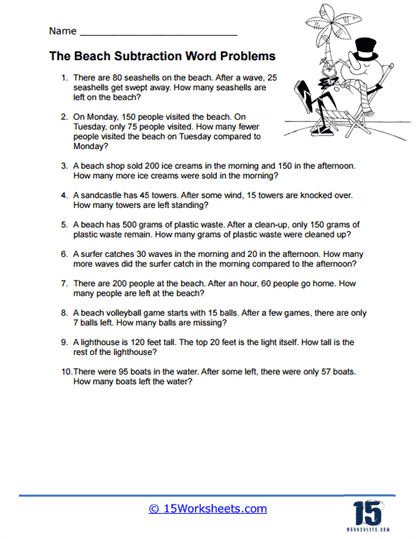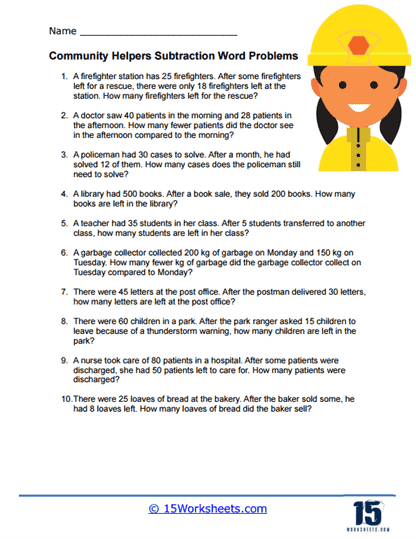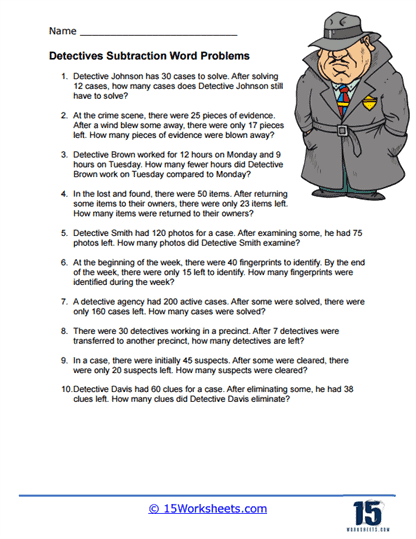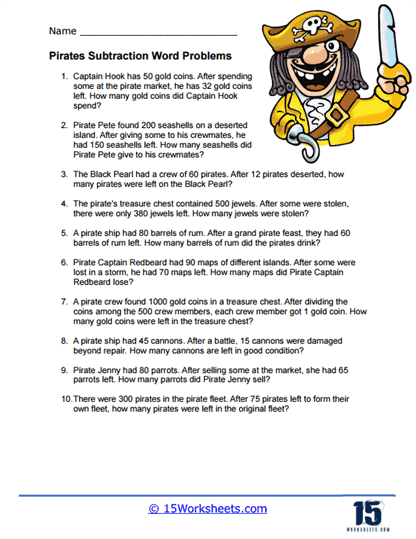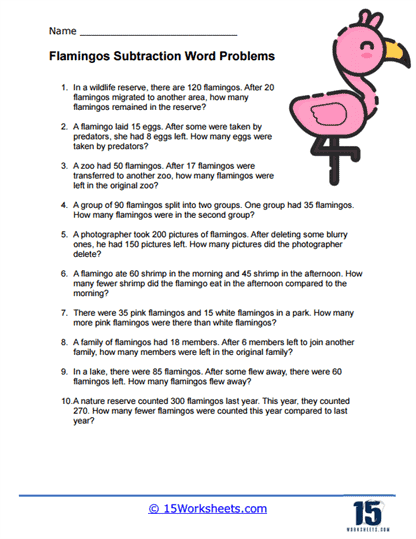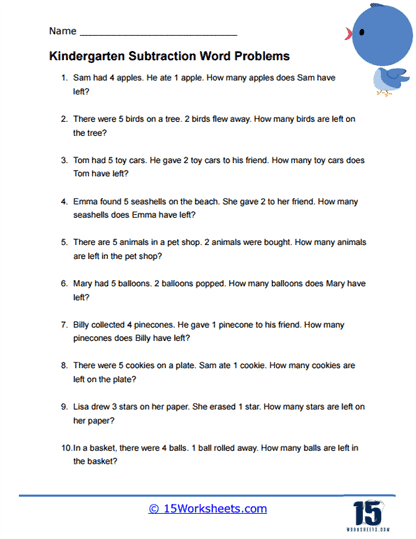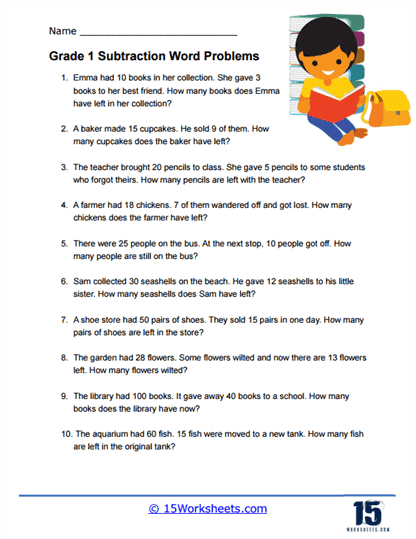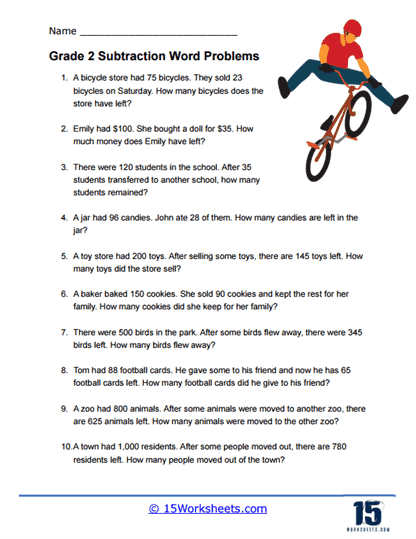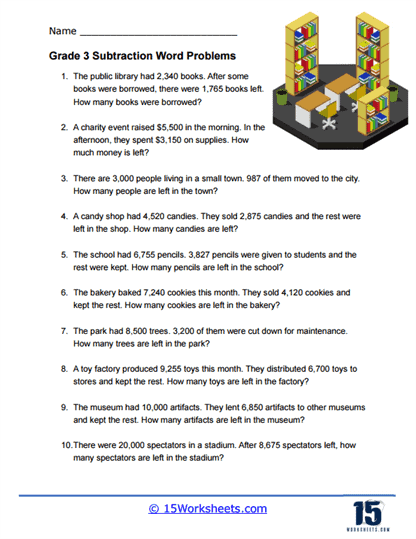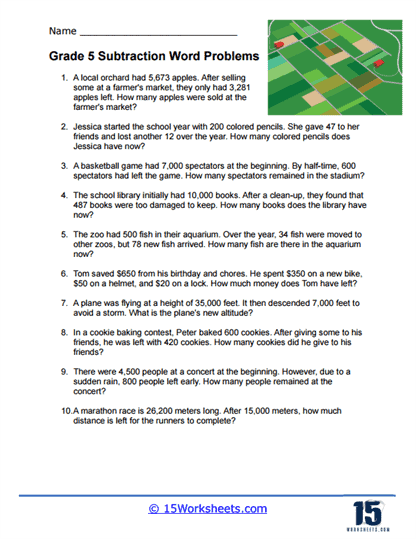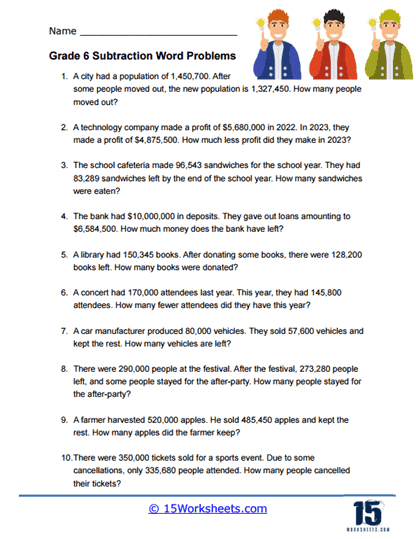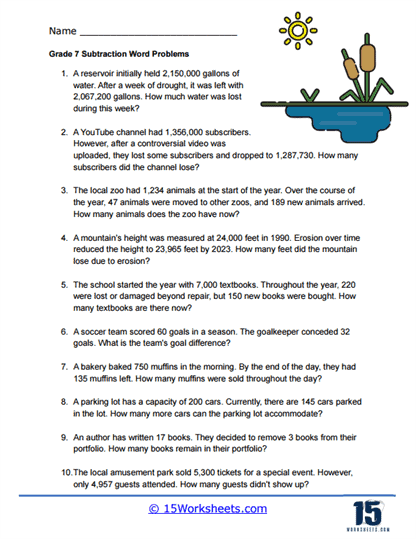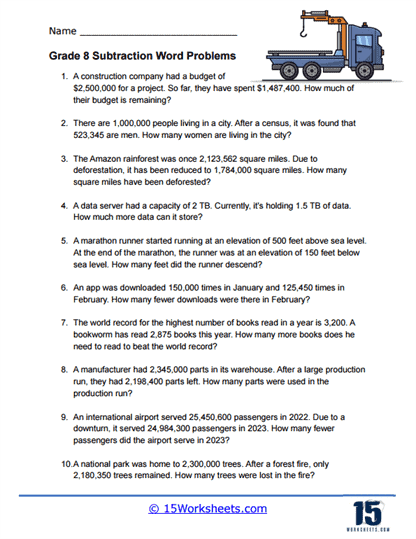Subtraction Word Problems Worksheets
About These 15 Worksheets
Subtraction word problem worksheets will help students develop their subtraction skills by solving real-world problems and scenarios that involve subtraction calculations. These worksheets provide practical contexts where students can apply their knowledge of subtraction concepts to find solutions. Subtraction is a fundamental mathematical operation, and these worksheets offer a practical way to develop and reinforce this essential skill.
Subtraction word problem worksheets cover a wide range of topics and complexity levels, making them suitable for different grade levels and skill levels. They can involve tasks such as finding the difference between quantities, calculating change, solving for missing values, or solving real-life situations that require subtraction calculations. These problems encourage students to interpret written information, identify relevant quantities that need to be subtracted, and perform the necessary operations to find solutions.
By working through subtraction word problem worksheets, students not only strengthen their subtraction skills but also develop critical thinking and problem-solving abilities. They learn to apply mathematical principles to practical contexts, improving their ability to make calculations accurately and efficiently in everyday life.
Subtraction word problem worksheets are a valuable tool for educators to assess students’ comprehension of subtraction concepts and their ability to apply subtraction principles to real-life scenarios. These worksheets can be used in the classroom to reinforce lessons, as homework assignments, or as part of standardized test preparation to ensure students have a strong foundation in subtraction skills.
How Do You Know When a Math Word Problem Requires Subtraction?
There are many different keywords or phrases that often indicate that subtraction is required to solve word problem. The keywords that often indicate this math operation are:
Difference – When the problem asks for the difference between two quantities or the amount by which one quantity is greater or smaller than another.
Examples of Subtraction Word Problems
Example – Find the difference between 15 and 9.
Decrease – When the problem describes a reduction or decrease in a quantity.
Example – If you decrease a number by 7, what is the result?
Subtract – When the problem explicitly mentions the operation of subtraction.
Example – Subtract 5 from 12.
Take away – When the problem involves removing or subtracting a certain quantity from a total.
Example – If you take away 3 from 8, what remains?
Less – When the problem implies a comparison or a smaller value.
Example – John has $10 less than Sarah. If Sarah has $25, how much does John have?
Fewer – When the problem involves comparing the number of items or quantities and implies a smaller count.
Example – If there are 9 apples and 5 oranges, how many fewer oranges are there than apples?
Remaining – When the problem asks for the amount or quantity that is left after subtracting or removing a portion.
Example – If you have 15 cookies and eat 8, how many cookies are remaining?
How many more/less – When the problem asks for the difference in quantity between two numbers.
Example – Jane has 10 pencils, and Mark has 5 pencils. How many more pencils does Jane have than Mark?
Net – When the problem involves a calculation of the net result or the difference between two opposing quantities.
Example – If the sales revenue is $500 and the expenses are $300, what is the net profit?
These keywords or phrases often suggest a subtraction operation, but it’s important to carefully analyze the problem and understand the context to determine the appropriate mathematical operation to use.
In word problems, determining whether subtraction is required depends on the specific context and the relationship between the quantities mentioned in the problem. Here are some indications that a word problem might involve subtraction:
Comparison of quantities – If the problem involves comparing two or more quantities to find the difference between them, subtraction is often necessary. Phrases like “how much more/less,” “difference between,” or “subtracted from” often indicate subtraction.
Example – Mary has 15 apples, and John has 9 apples. How many more apples does Mary have than John?
Change or decrease in value – If the problem describes a change or decrease in a quantity over time or due to some action, subtraction might be involved. This could be indicated by terms such as “decrease,” “reduce,” “subtract,” or “take away.”
Example – Sarah had $50, and she spent $25 on a book. How much money does she have left?
Missing part or unknown quantity – If the problem presents a scenario where part of a whole is missing or unknown, subtraction can help find the missing value. This can be indicated by phrases like “how much is left,” “how many are missing,” or “what is the remaining amount.”
Example – A class had 30 students, and 17 students are present. How many students are absent?
Removing or separating items – If the problem involves removing or separating items from a group or a total, subtraction is often used to find the resulting quantity.
Example – There were 50 marbles in a bag, and 8 marbles were taken out. How many marbles are left in the bag?
Finding the complement – If the problem asks for the value that, when subtracted from another value, results in a given total, subtraction is required.
Example – If the sum of two numbers is 20, and one of the numbers is 14, what is the value of the other number?
It’s important to carefully read and understand the wording of the problem to identify the relationship between quantities and determine when subtraction is appropriate. In some cases, visualizing the problem or representing it with diagrams or equations can also help determine if subtraction is needed.

